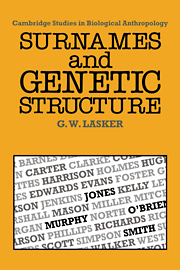Book contents
- Frontmatter
- Contents
- Preface
- 1 Introduction
- 2 History of surname studies in human biology
- 3 Sources of data
- 4 Methods
- 5 Isolates and inbreeding
- 6 Island versus distance models: the Far East and Oceania
- 7 The Americas and continental Europe
- 8 Scotland and Ireland
- 9 Regions of England
- 10 English cities and the general population of England and Wales
- 11 Specific surnames in Great Britain
- 12 Human population structure
- Literature cited
- Appendix maps and diagrams, of the distribution of 100 surnames in England and Wales
- Glossary
- Index
7 - The Americas and continental Europe
Published online by Cambridge University Press: 05 November 2011
- Frontmatter
- Contents
- Preface
- 1 Introduction
- 2 History of surname studies in human biology
- 3 Sources of data
- 4 Methods
- 5 Isolates and inbreeding
- 6 Island versus distance models: the Far East and Oceania
- 7 The Americas and continental Europe
- 8 Scotland and Ireland
- 9 Regions of England
- 10 English cities and the general population of England and Wales
- 11 Specific surnames in Great Britain
- 12 Human population structure
- Literature cited
- Appendix maps and diagrams, of the distribution of 100 surnames in England and Wales
- Glossary
- Index
Summary
Modern mainstream United States populations have been little investigated by surname analyses. A sample of names in a suburban Detroit telephone directory yields a low proportion of random isonymy, as one would expect from the heterogeneous ethnic origins of such populations. However, they are not true breeding populations and actual matings may be considerably more inbred. The diverse origins of Americans and consequent large numbers of different surnames – said to be over a million – imply low levels of isonymy. Because of considerable polyphyly of surnames and the high rate of name-changing that has characterized immigrants to the United States, the random component of inbreeding is probably even less than implied by random isonymy. However, in the early stages of immigration of each new group, the group seeks to keep its identity and members tend to marry among themselves, so the inbreeding rates may be similar to those of the country of origin. In fact, if the immigrant group is small, inbreeding may be more intense than in the place of origin. This would be reflected in the non-random component of inbreeding in the first few generations. Except for a few groups with very strong religious sanctions against intermarriage, such immigrant enclaves in the United States dissolve after one, two or three generations in the melting pot of urban America.
The classic study of Arner (1908) in the United States has already been cited.
- Type
- Chapter
- Information
- Surnames and Genetic Structure , pp. 43 - 49Publisher: Cambridge University PressPrint publication year: 1985



